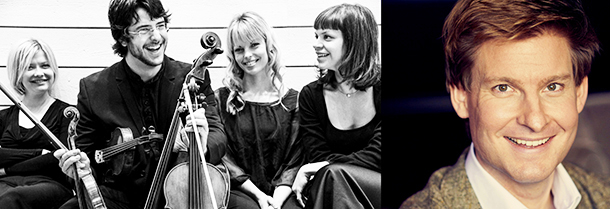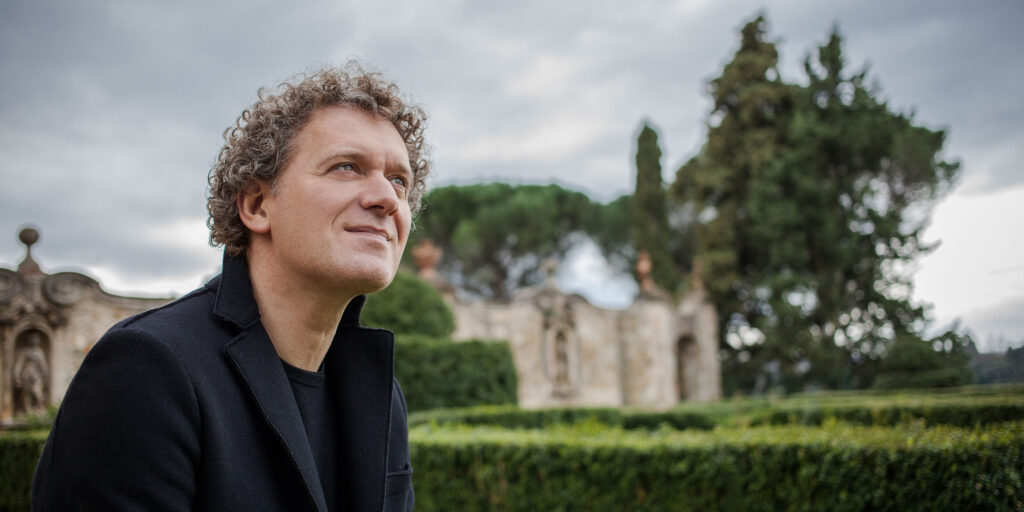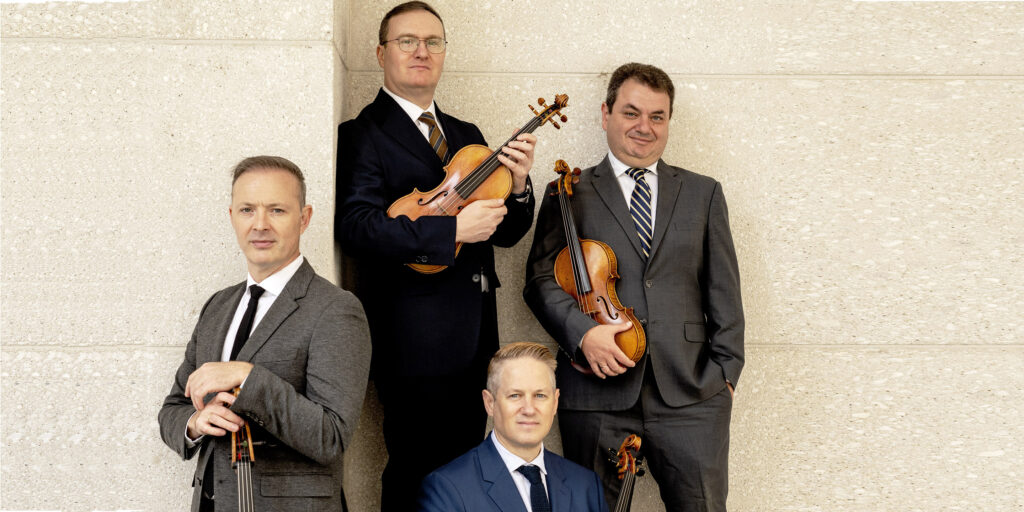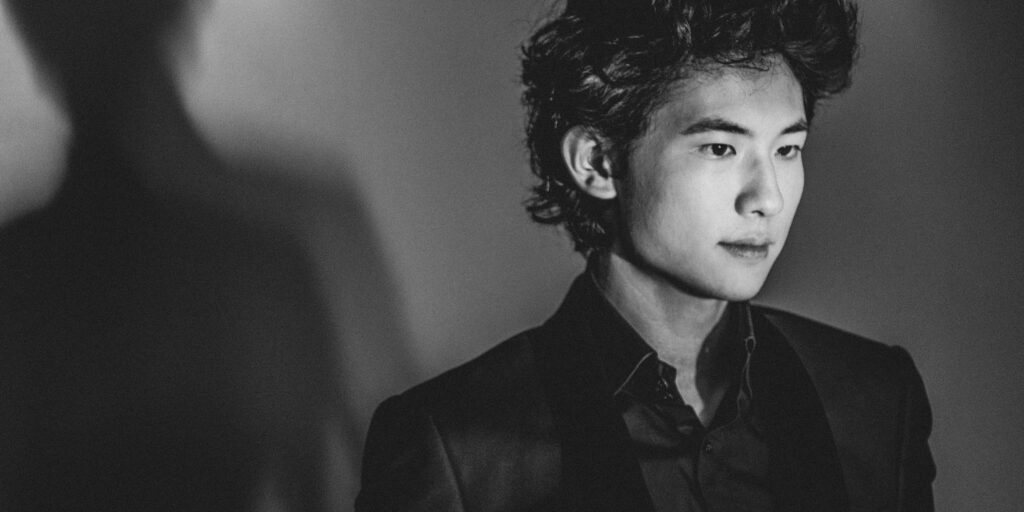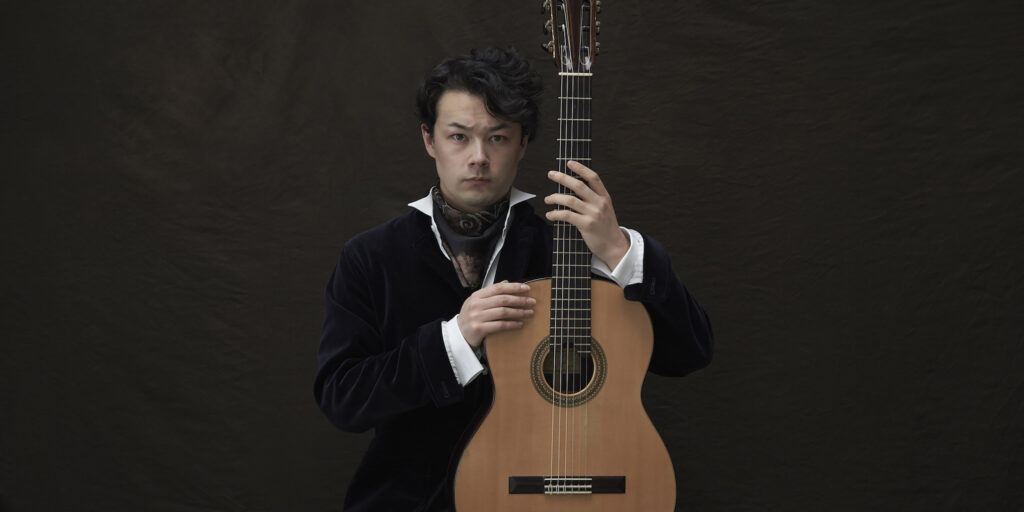Franz Schubert
String Quartet No. 14 in D minor (“Death & the Maiden”)
Schubert’s “Death and the Maiden” string quartet is a sombre work, with all four of its movements set in a minor key. It takes its name from the composer’s lied Der Tod und das Mädchen (1817) that provides the theme for the quartet’s slow movement, a set of variations. The poem’s depiction of Death coming to claim a young life may well have had personal resonance for the 27-year-old Schubert since in 1824, when this quartet was written, symptoms of the disease that would kill him four years later had already begun to appear.
Despite the despairing back-story, or perhaps because of it, the first movement of this quartet is unusually muscular in its scoring, thick with double-stop accompaniment patterns and punchy triple- and quadruple-stop chords at important cadences. This orchestral quality is evident from the startling salvo of string sound that opens the work, comparable in its dramatic abruptness to the opening of Beethoven’s Fifth Symphony. This fanfare-like call to attention announces the serious tone of the movement while at the same time introducing the descending triplet figure that will be the principal motive of its first theme, presented immediately following. The other important motive dominating the movement arrives in the work’s second theme: a small grouping of notes ending in a lilting dotted rhythm, lovingly offered up in thirds, Viennese-style.
Schubert’s treatment of these two motives in this movement displays his more ‘relaxed’ notion of the structural principles underlying classical sonata form. While composers in the era of Mozart and Haydn considered their key choices and modulation patterns to be the harmonic pillars and load-bearing walls of a sonata-form movement’s musical architecture, Schubert, by contrast, was more interested in interior decorating than structural engineering. Rejecting sonata form’s traditional concentration on just two tonal centres – the home key presented at the outset and its alternate, presented in the second theme – he preferred to spin his tonal colour wheel more freely so as to choose just the right tonal accent for this little motive here, and the right tonal shade to paint that broad thematic space there.
While not ignoring the form’s three-part division into exposition, development and recapitulation, Schubert lets this pattern out at the seams to create a more vibrant palette of harmonic possibilities. The tonal drama that interests him happens at a moment-by-moment pace, riding forward on waves of harmonic colour. The triplets that appear so portentous as the movement opens, when cast in different tonal colours, becomes a daisy-sniffing walk-in-the-park hummable tune. And the lilting dotted-rhythm motive, so gracious at its first appearance, becomes worrisome when constantly repeated in the minor mode.
Schubert’s treatment of his musical material in the following slow movement is much more regular and formally proportioned. The theme for this movement’s set of variations is in two parts, each repeated. The first is a direct quotation of the piano introduction to the Death and the Maiden lied, with its plodding funeral-march rhythm and mournful repetition of melody notes evoking the sorrow that death brings. The second part maintains the processional rhythm but is more hopeful, ending in the major mode to reflect the lied text’s depiction of death as the Great Comforter. Most of the variations decorate the theme with an elegant application of melodic embroidery in the first violin. But the third variation breaks this pattern with its frightening acceleration of the theme’s processional rhythm, a pacing that some have compared to the galloping of Death’s horse.
The Allegro molto scherzo is of a rough Beethovenian stamp, predicated on the play of small repeated motives, frequent syncopations, and sudden contrasts between piano and forte. Its Trio middle section is a gently swaying Ländler that counts as one of the few moments of sustained lyrical repose in this quartet.
The rondo finale, marked Presto, is a kaleidoscope of seemingly contradictory emotional states. Alternating between the driving vehemence of its tarantella refrain in the minor mode and the almost celebratory spirit of its major-mode episodes, this movement is bound together by its boundless energy alone, an energy that seems to transcend major-minor distinctions. Witness its whirlwind coda, that clearly signals an intention to end the work in the major mode only to switch back to the minor for its last hurrah, yet with no loss of breathless exuberance.
Wolfgang Amadeus Mozart
Piano Sonata No. 14 in C minor K 457
In 1785 Mozart’s Sonata in C minor was published together with the composer’s Fantasia in C minor as a single opus, with the Fantasia forming a kind of introductory ‘prelude’ to the sonata. Given that the Fantasia was composed many months after the sonata, scholars are divided as to whether this was Mozart’s intention or simply a clever marketing ploy on the part of his Viennese publisher. Certainly, the common key of C minor and a shared fondness for heightened musical drama link the two works. Not to mention how the practice of combining an improvisatory movement with a more formally rigorous one has traditional roots in the Baroque pairing of fantasy and fugue.
And yet this three-movement sonata is entirely capable of standing on its own. It is a small sonata with big ideas: operatic in its wide range of emotions, orchestral in many of its effects (especially its imitation of alternating orchestral ‘choirs’ of instruments), and pianistic in its unabashed display of quasi-virtuosic keyboard techniques, all of which have been cited as possible influences on – and perhaps even models for – some of the early sonatas of Beethoven in a minor key.
The work opens with an imperious fanfare: an arpeggio rising dramatically over more than an octave. This abrupt gesture looks back to a similar instrumental effect associated with mid-18th-century orchestras in south-west Germany called the “Mannheim rocket” while at the same time looking forward to a similar opening in Beethoven’s first piano sonata, the Sonata in F minor Op. 2 No. 1.
Cowering in the upper register of the keyboard where this fanfare left off is a timid little answer full of plaintive sighs. A subsequent repeat of this Punch & Judy show establishes from the outset the wide emotional range that this sonata will claim for itself. Indeed, off-beat accents and abrupt juxtapositions of loud and soft are recurring features of the movement, features that may have given Beethoven ideas to follow up on.
The movement’s second theme, singing out in the major mode atop a burbling Alberti bass is more sociable, with hand-crossing replies echoing up from the bass. But even this theme is not immune to unexpected interruptions. One of the most dramatic is a passage of broken-chord figuration that extends from the bottom to the very top of the fortepiano keyboard of Mozart’s time, an indication that this movement may have been written for the composer’s personal use, with his own hand in mind. He was known to be a bit of a show-off at times, we hear.
The second-movement Adagio is no less spectacular in its own way. It is a study in melodic ornamentation and remarkable for the myriad possibilities that Mozart finds to decorate its simple melodic structures, structured around chord tones that sit on top of an audaciously rudimentary harmonic undergirding. Slow movements are not normally the place for virtuoso fireworks, but included in the decorative detail of this slow movement are breathtaking ecstatic runs spanning more than three octaves that astonish the ear.
The Allegro assai finale is a rondo that returns to the restlessness mood of the first movement, typified by the confrontational manner in which its opening refrain melody is structured. It begins piano with a series of suspensions that evoke a feeling of whimpering pathos, but then turns on a dime to become aggressive and insistent, with shoulder-poking repeated notes ringing out forte in a foretaste of the rondo refrain from Beethoven’s Pathétique Sonata. Even the coquettish quality of this rondo’s interludes cannot mask the troubled atmosphere evoked by its many sudden changes in dynamics and the searching quality of its numerous dramatic pauses. This is Mozart at his most ‘Beethovenian’.
Wolfgang Amadeus Mozart
Piano Concerto No. 12 in A major K 414
Mozart’s twelfth piano concerto was one of three composed in 1782 for sale to the Viennese public by advance subscription, the 18th-century equivalent of ‘crowd-sourcing’. A major selling point of these ‘subscription’ concertos (K. 413, 414 & 415) was that they were composed not only for concert use but also for performance at home by a fortepiano and string quartet, as the wind parts were not structurally important and could easily be dispensed with.
The Concerto in A major K. 414 has always been the favourite of the set, perhaps because it displays so well the one trait that sets Mozart’s piano concertos apart from those of his contemporaries, i.e., their ‘operatic’ quality. A piano concerto by Mozart is poles apart from the concerto genre as practised in the Baroque era, when the soloist was treated as part of the orchestra, playing along during the tuttis and emerging from time to time to play ‘lead breaks’ before folding back into the ensemble texture again.
Mozart’s soloist is an operatic diva, a faultlessly courteous one, of course, but one who is definitely the star attraction of the show. Her entrance is a major event in each movement, one that we are made to wait for. The form of Mozart’s first movements, with their ‘double exposition’ of themes parallels the ritornello form of the operatic aria, and for the same reason. The opening orchestral tutti not only presents the major themes of the movement but more importantly, as in opera, it builds up anticipation for the soloist’s first utterance.
Moreover, Mozart is in no way loathe to trust the piano with lyrical, even sentimental melodies requiring a sustained ‘singing’ tone in the gracious manner of Italian opera, unlike Haydn, whose vigorous and ‘knuckle-y’ keyboard style often presupposes a certain crispness of touch. Furthermore, the soloist’s cadenzas in a Mozart piano concerto serve not only to display the technical facility of the performer, but also through their changes of tempo, their sudden hesitations, their succession of moods, they convey the capricious ‘personality’ of the character that the instrument plays in the musical drama.
The first movement of the A major concerto is remarkable for the profusion of themes that it presents—four in the orchestral exposition alone. The second of these themes is accompanied by a leering countermelody in the viola that evokes the intimacy and camaraderie of chamber music more than the starched formality of the concert hall. The development section, as it would be called in sonata form, reveals just how wobbly is the notion that the Classical concerto is simply a sonata arranged for soloist and orchestra. Not only does the piano introduce an entirely new theme to start things off, but it then goes on to snub all the themes of the exposition, immersing itself deeply in the minor mode, like the contrasting B section of an operatic da capo aria, reaching a climax of excitement in a thrilling series of high trills followed by a multi-octave scale plunging to the bottom of the keyboard. This concerto simply oozes personality, with cadenzas provided for all three movements.
The second movement opens with a direct quote from an overture to Baldassare Galuppi’s La Calamità dei cuori written by Johann Christian Bach (1735-1782), youngest son of J. S. Bach. Mozart had met and been befriended by J. C. Bach while still a young child, so the elder composer’s death earlier in the year has been suggested as the motivation for this tribute. And certainly, the many unusual passages in the minor mode in this movement support that view.
The last movement is a sonata rondo with a great profusion of themes but a quite eccentric formal structure. The orchestra briefly introduces two themes, the first a skipping tune decorated with trills followed by a unison passage featuring a repetitive motive of three notes descending by step. When the piano enters, however, it ignores both of these, choosing instead to spin out its own tune. It does eventually get around to taking up the tunes presented by the orchestra, but more surprises await when the piano cadenza ends up in a dialogue with the orchestra! Filled with thrills and spills, this concerto gave its Viennese audience quite an exhilarating ride.
Donald G. Gíslason 2019


